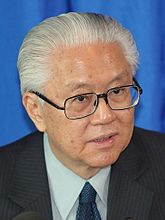Presidential Elections Committee
| President of the Republic of Singapore |
|
|---|---|

Presidential Crest
|
|

Presidential Standard
|
|
| Style | His/Her Excellency |
| Residence | Istana |
| Appointer | Elected by Parliament (1965–1991) Direct popular election (1991–present) |
| Term length | Six years; renewable |
| Inaugural holder | Yusof Ishak |
| Formation | 9 August 1965 |
| Website | www |
The President of the Republic of Singapore is Singapore's head of state. In a Westminster parliamentary system, as which Singapore governs itself, the prime minister is the head of the government while the president is largely ceremonial, broadly analogous to the Sovereign of the United Kingdom.
Before 1993, the President of Singapore was chosen by Parliament. Following constitutional amendments in 1991, the Presidency became a popularly elected office with certain custodial powers, particularly over government expenditure of the nation's past financial reserves and key appointments to public offices.
In November 2016, further amendments provide for "reserved elections" for a particular racial group (Chinese, Malay and Indian/other minority) - if that community has not been represented for five presidential terms.
The first President elected by the majority of the people was Ong Teng Cheong, who served from 1 September 1993 to 31 August 1999. The current President of Singapore is Tony Tan Keng Yam. The President's official residence is the Istana.
The office of President was created in 1965 after Singapore became a republic upon its secession from the Federation of Malaysia that year. It replaced the office of Yang di-Pertuan Negara, which had been created when Singapore attained self-government in 1959. The last Yang di-Pertuan Negara, Yusof Ishak, became the first President. After his death he was replaced by Benjamin Sheares, who served until his death in 1981, when he was succeeded by Chengara Veetil Devan Nair. Owing to personal problems, Nair stepped down in 1985 and was replaced by Wee Kim Wee, who served as President until 1993.
...
Wikipedia

